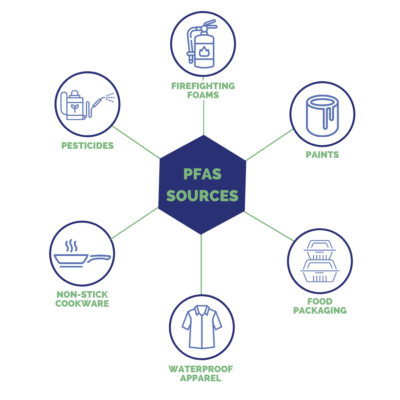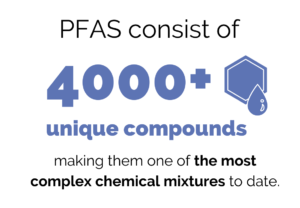PFAS in the Chesapeake Bay Region
 The December CRC Roundtable webinar focused on what we currently know about per- and polyfluoroalkyl substances (PFAS), what we need to know, and how the Bay states and EPA are tackling the issue.
The December CRC Roundtable webinar focused on what we currently know about per- and polyfluoroalkyl substances (PFAS), what we need to know, and how the Bay states and EPA are tackling the issue.
PFAS, also known as forever chemicals, have been used in the U.S. since the 1940s. They consist of more than 4000 unique compounds, making them one of the most complex chemical mixtures to date. PFAS are used as firefighting foams, and in consumer products such as water repellent fabrics, personal care products, food packaging, nonstick surfaces, and more. Numerous PFAS are present in the environment and have the potential to adversely affect human health and aquatic life. Current scientific research suggests that exposure to high levels of certain PFAS may lead to adverse health outcomes, such as reproductive and developmental effects. However, research is still ongoing to determine how different levels of exposure to different PFAS can lead to a variety of health effects.
 Bay states are also actively monitoring for PFAS and are continuing to gather information on occurrence and potential effects. The Chesapeake Bay Program Science and Technical Advisory Council is hosting a workshop to gather state, federal and academic partners to better understand the state of the science and improve science coordination on PFAS. The goals of the workshop include summarizing current understandings of the sources, occurrence, and fate of PFAS; identifying ongoing current efforts; approaches to inform the potential effects on fish and wildlife as well as their consumption; and considering study designs to compare sampling and analytical methods to have a more coordinated PFAS scientific effort throughout the Bay.
Bay states are also actively monitoring for PFAS and are continuing to gather information on occurrence and potential effects. The Chesapeake Bay Program Science and Technical Advisory Council is hosting a workshop to gather state, federal and academic partners to better understand the state of the science and improve science coordination on PFAS. The goals of the workshop include summarizing current understandings of the sources, occurrence, and fate of PFAS; identifying ongoing current efforts; approaches to inform the potential effects on fish and wildlife as well as their consumption; and considering study designs to compare sampling and analytical methods to have a more coordinated PFAS scientific effort throughout the Bay.
Kelly Smalling, a research hydrologist with the United States Geological Survey (USGS), and Scott Phillips, Chesapeake Bay Coordinator with the USGS, moderated the webinar with three expert speakers. The three speakers, Amy Williams, Pennsylvania Department of Environmental Protection’s Bureau of Clean Water; Lee Currey, Maryland Department of the Environment; and Betsy Behl, Environmental Protection Agency (EPA), provided a unique perspective on PFAS and briefly summarized some ongoing efforts focusing on what they’ve learned and what’s next.
Takeaways from the webinar
Amy Williams is a Water Program Specialist with the Pennsylvania Department of Environmental Protection’s Bureau of Clean Water and spoke on ongoing efforts in Pennsylvania including:
- A study to sample PFAS at 178 water quality network (WQN) stations in Pennsylvania. These stations are targeted sites that are sampled routinely for a number of compounds over multiple years to develop trends data, not just for PFAS. They sampled for 33 PFAS chemicals and 19 total oxidizable precursors (TOP) chemicals and found the highest concentrations in the southeast corner of the state, in the Neshaminy Creek in Langhorne, PA specifically.
- A fish tissue advisory on the Neshaminy Creek basin, including at the Neshaminy Creek State Park and Tyler State Park. It’s the first fish tissue advisory from PFOS. The levels detected in fish tissue samples were over the 0.2 parts per million “do not eat” advisory level.
- Future plans to sample 20 sites across the state in coordination with USGS, with sampling focused on problem areas. The department is going to sample more in the Neshaminy basin and above dams to determine the extent of the advisory and hopefully, that will help with source tracking.
Lee Currey is the Director of Water and Science Administration at the Maryland Department of the Environment discussed work in Maryland on PFAS including:
- Drinking water sampling analysis of more than 500 samples from over 200 community water systems, which resulted in five different water systems that had elevated levels, but potentially more if EPA revises their health advisory. These elevated levels are in groundwater specifically, not surface waters, which are all below the limit of 10 parts per trillion.
- A pilot study looking at a sample of oysters and surface water throughout the St Mary’s river, which did not find any PFAS in oyster tissue, but led to testing finfish for detections.
Betsy Behl is the Director of the Health and Ecological Criteria Division with the EPA and discussed some of the information from the roadmap and described EPA efforts from a national perspective. In 2016, the EPA introduced the current non-enforceable lifetime human health advisories for drinking water for Perfluorooctanoic Acid (PFOA) and Perfluorooctane Sulfonate (PFOS), two of the most widely used and studied chemicals in the PFAS group. In October 2021, EPA released its PFAS strategic roadmap, which is designed to consider the entire lifecycle of PFAS, from their unique properties, the ubiquity of their uses in everyday products, and the multiple pathways of exposure. This comprehensive strategy by EPA is designed to protect public health and ecosystems by researching, restricting, and remediating PFAS contamination.
- The goal of the roadmap is to consider the lifecycle of PFAS and to get upstream of the problem, hold leaders accountable, enhance the science, and protect disadvantaged communities.
- Future actions from the Office of Chemical Safety and Pollution Prevention and Office of Water, including:
- Publish a national PFAS testing strategy
- Ensure a robust review process for new PFAS
- Undertake nationwide monitoring for PFAS in drinking water
- Establish a national primary drinking water regulation for PFOA and PFOS
- And many more, which can be found on the EPA PFAS site.
Resources for further action
- Pennsylvania Department of Environmental Protection Bureau of Safe Drinking Water PFAS Sampling Plan
- Neshaminy basin fish tissue advisory
- PA DEP Emerging Contaminant Page (PFAS about halfway down)
- PADEP data
- Maryland and PFAS
- EPA PFAS
- CWA Analytical Methods for Per- and Polyfluorinated Alkyl Substances (PFAS)
- Contact Adrian Hanley in the Engineering and Analysis Division (Hanley.adrian@epa@epa.gov) regarding the development of this method
Next steps
Please check the Chesapeake Bay Program Science and Technical Advisory Council website for updates on the PFAS workshop and how to participate.
